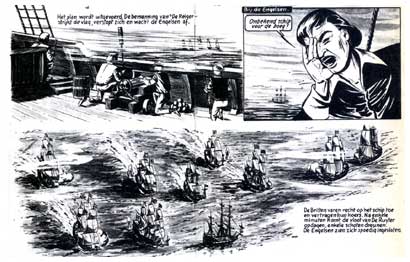'Pinocchio in de Ruimte' (Kuifje, 1965).
Willy Lateste was a Belgian animator and occasional comic artist. For the comic magazine Ons Volkske, he created a couple of historical comics in a realistic drawing style. As an employee of Belvision, he was animator and script supervisor for two animated 'Astérix' features, 'Asterix the Gaul' (1967) and 'Asterix and Cleopatra' (1968), as well as the box office flop 'Pinocchio en Espace' (Pinocchio In Space', 1965). He adapted the latter film into a comic strip, serialized in Tintin magazine.
Early life and career
Willy Lateste was born in 1930 in the Flemish coastal city Ostend. In the mid-1950s, he found employment with the publishing house Le Lombard and its animation division Belvision. The studio was founded by Lombard publisher Raymond Leblanc and his associate Karel van Milleghem to produce animated shorts based on the popular comic book characters from their magazine, Tintin. Taking off in 1954, the studio was initially run by Van Milleghem and camera operator Jos Marissen. After several try-outs with rudimentary animated shorts based on Willy Vandersteen's 'Suske en Wiske', the studios quickly branched out with the additional technicians Hugo Noe and Ivan Scuzs, as well as the artists Bob Zicot and Willy Lateste. Their first project was creating animations based on the 'Tintin' albums 'King Ottokar's Sceptre' and 'The Broken Ear'. Even though the films were done under artistic supervision of Hergé's right hand man Bob de Moor, the quality left a lot to be desired and the project was shelved. Using artwork from the original albums, it proved difficult to achieve a plausible suggestion of movement to the characters. In 1957, Ray Goossens was hired as lead animator, which quickly improved the craft of the Belvision team.
Ons Volkske
During his time with Belvision, Willy Lateste also tried his hand at comic book art. In the late 1950s, he created several historical comics for the Flemish magazine Ons Volkske, which was also produced by the Lombard team. Among Lateste's comics were 'Vader des Vaderlands' (1957-1958) about William the Silent, AKA the Prince of Orange, and 'Michiel de Ruyter' (1958), about the Dutch admiral.
'Michiel de Ruyter' (1958).
Pinocchio In Space
Since the start in 1954, Belvision had mostly produced animated shorts for television, but in 1965, they released their first full-blown animated feature, 'Pinocchio Dans l'Espace'/'Pinocchio In De Ruimte' ('Pinocchio in Space', 1965), directed by Ray Goossens. Loosely based on Carlo Collodi's novel 'Pinocchio', the famous wooden puppet boy now found himself in a science fiction context, where he has to defend Earth from a whale traveling through space. To promote the picture, Lateste drew a comic strip adaptation, which ran in Tintin magazine from 23 March 1965 (issue #12) up until 25 May 1965 (issue #21). However, the film was a huge critical and commercial disaster, but a book version was still released in Dutch by Lombard and in French by Dargaud. The Belgian chocolate brand Jacques also distributed imagery from the film on stickers, which children could collect for a cut-and-paste sticker album.
Asterix films
Belvision quickly embarked on another animated feature, 'Astérix Le Gaulois' ('Astérix The Gaul', 1967), based on René Goscinny and Albert Uderzo's popular comic series 'Astérix'. This was consequently the first time the invincible Gaul was adapted to the big screen. The picture did well at the box office, though series creators Goscinny and Uderzo took legal action since they weren't involved in the project. A settlement was reached and by the time the next 'Astérix' film came out, 'Astérix et Cléopâtre' ('Astérix and Cleopatra', 1968), the authors were directly involved. Vastly superior to its predecessor thanks to Goscinny's creative input, the picture became a classic. Lateste animated and wrote the screenplay for both pictures, but never saw the release of 'Astérix and Cleopatra', as he passed away in 1967.
Family connections
Willy Lateste's brother Eddie Lateste (1929) joined Belvision in 1960. He was a scriptwriter and animation supervisor for 'Astérix and Cleopatra' and later directed two other comics-based animated features for Belvision, namely 'Le Temple du Soleil' ('Prisoners of the Sun', 1969), based on Hergé's 'Tintin' album, 'Tintin et le Lac aux Requins' ('Tintin and the Lake of Sharks', 1972), which he also co-produced, and 'La Flûte à Six Schtroumpfs' ('The Flute with the Six Smurfs', 1976), based on the 'Smurfs' album by Peyo. In 1971, he was animator on Goscinny and Morris' 'Daisy Town' (1971), based on the series 'Lucky Luke'.
'Pinocchio In De Ruimte', Dutch-language version (Kuifje #29. 20 July 1965).





